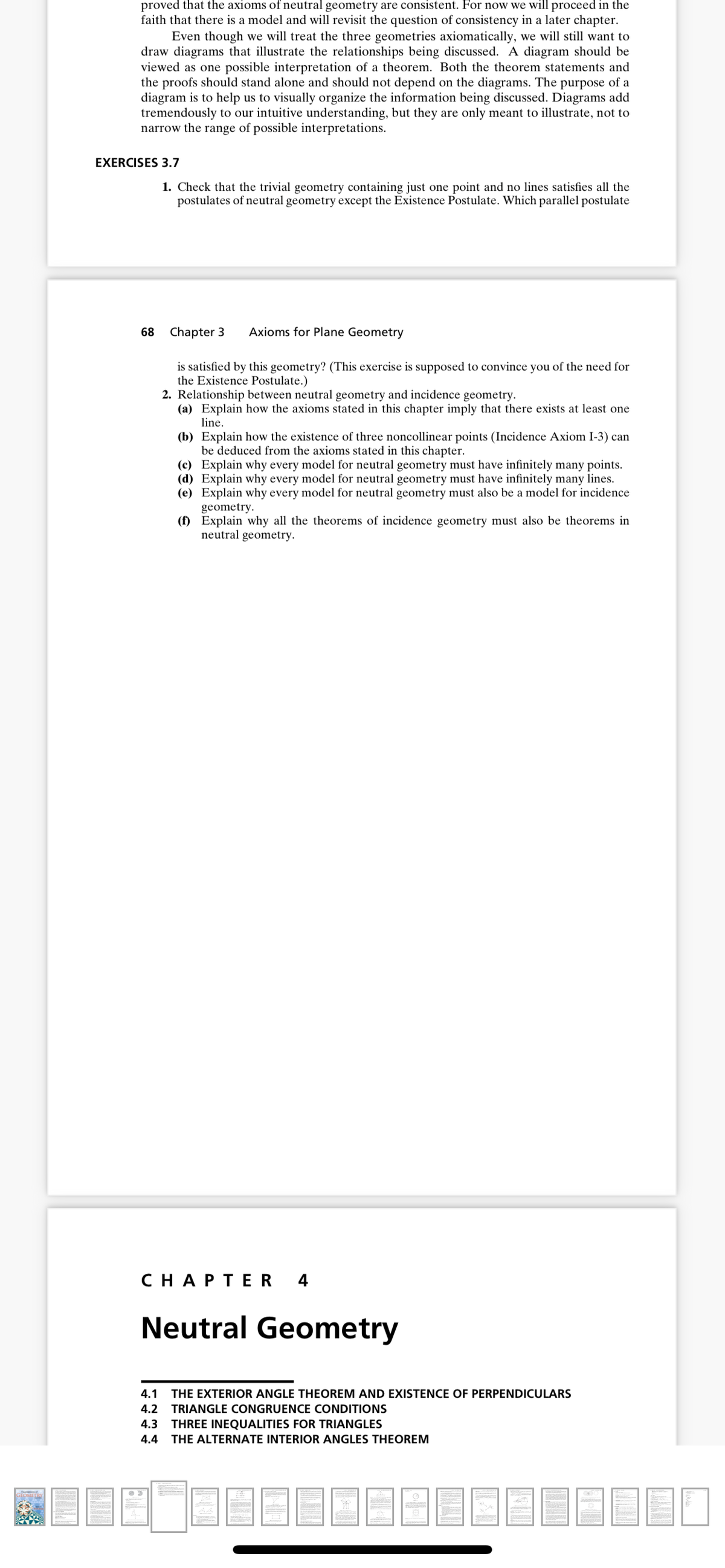2. Relationship between neutral geometry and incidence geometry. (a) Explain how the axioms stated in this chapter imply that there exists at least one line. (b) Explain how the existence of three noncollinear points (Incidence Axiom I-3) can be deduced from the axioms stated in this chapter. (c) Explain why every model for neutral geometry must have infinitely many points. (d) Explain why every model for neutral geometry must have infinitely many lines. (e) Explain why every model for neutral geometry must also be a model for incidence geometry. (f) Explain why all the theorems of incidence geometry must also be theorems in neutral geometry.
2. Relationship between neutral geometry and incidence geometry. (a) Explain how the axioms stated in this chapter imply that there exists at least one line. (b) Explain how the existence of three noncollinear points (Incidence Axiom I-3) can be deduced from the axioms stated in this chapter. (c) Explain why every model for neutral geometry must have infinitely many points. (d) Explain why every model for neutral geometry must have infinitely many lines. (e) Explain why every model for neutral geometry must also be a model for incidence geometry. (f) Explain why all the theorems of incidence geometry must also be theorems in neutral geometry.
Linear Algebra: A Modern Introduction
4th Edition
ISBN:9781285463247
Author:David Poole
Publisher:David Poole
Chapter1: Vectors
Section1.2: Length And Angle: The Dot Product
Problem 5AEXP
Related questions
Question
Question 2

Transcribed Image Text:proved that the axioms of neutral geometry are consistent. For now we will proceed in the
faith that there is a model and will revisit the question of consistency in a later chapter.
Even though we will treat the three geometries axiomatically, we will still want to
draw diagrams that illustrate the relationships being discussed. A diagram should be
viewed as one possible interpretation of a theorem. Both the theorem statements and
the proofs should stand alone and should not depend on the diagrams. The purpose of a
diagram is to help us to visually organize the information being discussed. Diagrams add
tremendously to our intuitive understanding, but they are only meant to illustrate, not to
narrow the range of possible interpretations.
EXERCISES 3.7
1. Check that the trivial geometry containing just one point and no lines satisfies all the
postulates of neutral geometry except the Existence Postulate. Which parallel postulate
68
Chapter 3
Axioms for Plane Geometry
is satisfied by this geometry? (This exercise is supposed to convince you of the need for
the Existence Postulate.)
2. Relationship between neutral geometry and incidence geometry.
(a) Explain how the axioms stated in this chapter imply that there exists at least one
line.
(b) Explain how the existence of three noncollinear points (Incidence Axiom I-3) can
be deduced from the axioms stated in this chapter.
(c) Explain why every model for neutral geometry must have infinitely many points.
(d) Explain why every model for neutral geometry must have infinitely many lines.
(e) Explain why every model for neutral geometry must also be a model for incidence
geometry.
(f) Explain why all the theorems of incidence geometry must also be theorems in
neutral geometry.
СНАРТER
4
Neutral Geometry
4.1
THE EXTERIOR ANGLE THEOREM AND EXISTENCE OF PERPENDICULARS
4.2 TRIANGLE CONGRUENCE CONDITIONS
4.3
THREE INEQUALITIES FOR TRIANGLES
4.4
THE ALTERNATE INTERIOR ANGLES THEOREM
Expert Solution
This question has been solved!
Explore an expertly crafted, step-by-step solution for a thorough understanding of key concepts.
This is a popular solution!
Trending now
This is a popular solution!
Step by step
Solved in 3 steps

Recommended textbooks for you

Linear Algebra: A Modern Introduction
Algebra
ISBN:
9781285463247
Author:
David Poole
Publisher:
Cengage Learning

Elementary Geometry For College Students, 7e
Geometry
ISBN:
9781337614085
Author:
Alexander, Daniel C.; Koeberlein, Geralyn M.
Publisher:
Cengage,

Linear Algebra: A Modern Introduction
Algebra
ISBN:
9781285463247
Author:
David Poole
Publisher:
Cengage Learning

Elementary Geometry For College Students, 7e
Geometry
ISBN:
9781337614085
Author:
Alexander, Daniel C.; Koeberlein, Geralyn M.
Publisher:
Cengage,